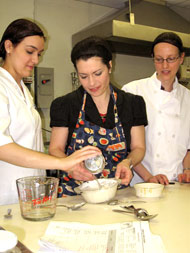The business side of dietetics
The white and red table cloth, maple leaf decorations, square dance music and virtual fireplace transformed the Faculty Lounge of Macdonald Campus into a cozy sugar shack at lunch time on March 28. Yes, maple syrup was all over the menu: in the balsamic vinaigrette that dressed the salad, as a glaze on chicken, in a fondue with strawberries and even in coffee with cinnamon. No oreilles de Christ on the menu, but getting hungry anyway?

Food Lab Manager Judy A. Campbell-Gordon (centre) thickens pea soup with the help of U2 dietetics students Sandra Bulancea (left) and Jana Ranger (right).
In March, Nutrition Month, all second-year students in dietetics had to make lunch for 45 to 50 people as part of their education program. Each one of 12 meal ventures had a theme, so that hungry customers could travel from Thailand to Morocco or learn about the nutritional facets of menus such as heart-healthy and gluten-free.
The experience takes dietetics far beyond the counting of calories: students learn to run a business from scratch.
While they are acquiring food safety knowledge to become certified nationally at the management level, they have to prepare a business proposal to operate a food service operation.
The five members of the team gain practical experience in management, developing job analyses, scheduling and training employees, creating menus and budgeting.
The future dietitians are also trained to use industrial food service equipment and to adapt a recipe for a small group of people to a larger one.
“You can’t transform a recipe for five people simply by multiplying the ingredients by 10 if you cook for 50,” explained Judy A. Campbell-Gordon, the Food Lab Manager in the School of Dietetics and Human Nutrition. “The preparation methods change drastically when using industrial equipment.”
The course is a great learning experience for students who become managers, cooks and waitresses for a day. By the way, no guests missed the oreilles de Christ.

